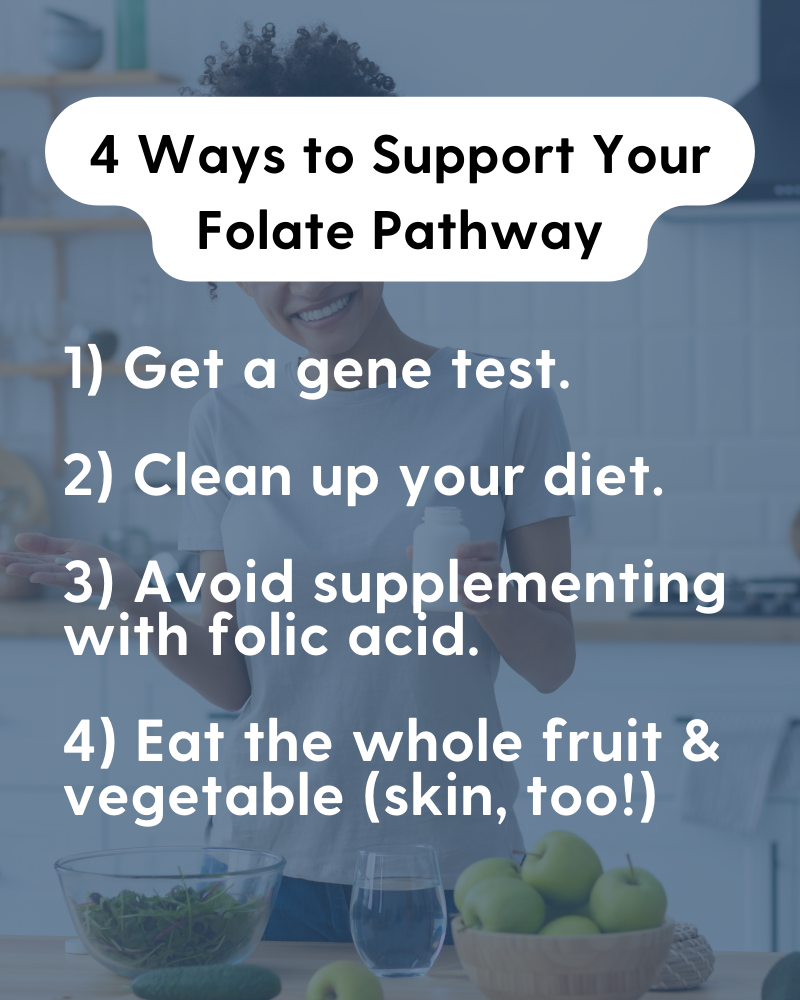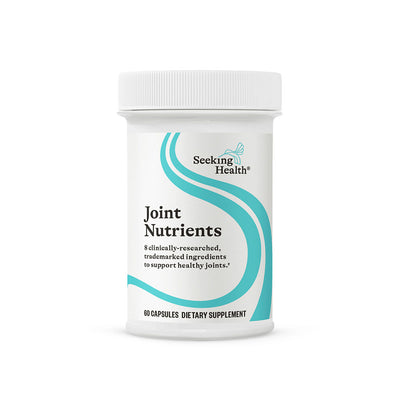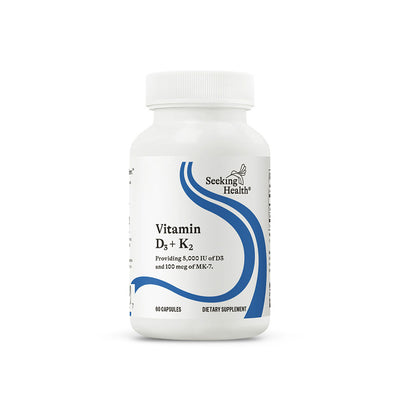Folate is a nutrient that is crucial for your health. Whether you are pregnant, trying to conceive, want to support good methylation, or just want to be a healthy person, you need enough folate for crucial biochemical processes.† Also known as vitamin B9, folate is found in many supplements. But folate is not just a form of folic acid. In this article, we’ll explore why it is important to understand the difference between types of folate and how each one can impact your health.
What is the Difference Between Folic Acid, Folate, and L-Methylfolate?
There are many different forms of vitamin B9. It can feel confusing to know which one to take, what they do, and why some are better for you than others. Here is a quick summary of the different types of folate:
- Synthetic folic acid: This man-made vitamin has a low absorption rate. It competes with natural folates to bind to the DHFR enzyme. Folic acid is added to processed foods, which is known as fortification. It is also commonly found in mainstream multivitamin supplements.
- Natural dietary folates: Natural folate is found in many foods. Pteroylpolyglutamates are the type of folate found in vegetables. After they are digested, they become monoglutamate derivatives, the only natural form of folate found in the bloodstream that can be absorbed into cells. The FPGS enzyme converts monoglutamate derivatives into polyglutamate by adding glutamate, which traps folate inside the cells so they are available for biochemical reactions like DNA synthesis or methylation.
- Folinic acid: This is an active form of folate. It is used to treat folate deficiency that causes anemia. MTHFD1 and SHMT genes and enzymes both play important roles in forming folinic acid. It can also be taken in supplement form, but unlike folic acid, it does not block the DHFR enzyme.†
- L-Methylfolate: This is a methylated active form of folate. It is the end-product of the folate pathway that supports methylation and the production of SAMe. You can also supplement directly with L-5-MTHF.
Synthetic Folic Acid
Folic acid is a synthetic form of vitamin B9. It is commonly found in multivitamins, especially prenatal vitamins, B complex vitamins, and folic acid supplements. It is also added to fortified foods like breakfast cereal, flour, and bread. In the U.S., it is possible for synthetic folic acid intake to be higher than 1 mg per day when a diet is high in these refined grain products. Yet high levels of unmetabolized folic acid have been found with intakes as low as 200 mcg (micrograms). (1) Food fortification started because neural tube defects (NTDs) were increasing in the population. (2) Because a deficiency of folate can contribute to NTDs, grain-based foods were fortified to increase the intake in the general population. Women of childbearing age should also increase folic acid supplementation, according to conventional medical advice, because of its high absorption rate. (3) However, absorption is not the same as bioavailability. Folic acid intake can negatively affect enzyme function in the folate pathway, and may also decrease vitamin B12 absorption in the small intestine. Synthetic folic acid in fortified foods should not be confused with natural folate that is found in foods like broccoli, Brussels sprouts, spinach, and asparagus.
The Problem with Folic Acid
Like all folates, to become active, folic acid needs to be converted to tetrahydrofolate (THF) by the enzyme dihydrofolate reductase (DHFR). DHFR enzyme activity is naturally slow in humans. It can become an average of 56 times slower when folic acid is present. (1) Not only is folic acid a poor substrate, but it also inhibits the DHFR enzyme from reducing natural dietary folate. It can serve as a roadblock for getting to the endgame of making 5-MTHF. Your diet can also influence how your body responds to folic acid.
- If you already eat a lot of folic acid from fortified foods, taking more in supplement form increases the amount competing for DHFR binding sites, crowding out whatever small amount of natural dietary folate you get. This slows down the whole folate pathway.
- If you eat a diet low in processed and fortified foods, and you eat a lot of folate-rich foods, more 7,8-DHF will be able to bind with the DHFR enzyme. This will naturally increase the amount of 5-methyltetrahydrofolate (5-MTHF) or active folate available in your body.
Because folic acid can block the absorption of natural dietary folate, and interfere with the ability to convert folate to 5-MTHF, people who have DHFR polymorphisms are at an increased risk for folate deficiency. Some research has linked this SNP with worsening memory function in people who were taking multivitamins. (4) DHFR is also needed to make neurotransmitters like dopamine, serotonin, and norepinephrine. Consuming folic acid that further slows DHFR enzyme function can have a negative impact on the nervous system and overall neurological function.
DHFR and Biopterin
In addition to its role in the folate pathway, DHFR also has a function in the biopterin pathway. It is required to recycle oxidized dihydrobiopterin (BH2) back to tetrahydrobiopterin (BH4). BH4 is an essential nutrient for neurotransmitter production, brain neurochemistry, and healthy cardiovascular function. Biopterin in its reduced form BH4 is a critical cofactor for the function of crucial enzymes like:
- Phenylalanine hydroxylase (PAH) and tyrosine hydroxylase (TH) that are needed for dopamine, norepinephrine, and epinephrine synthesis.
- Tryptophan hydroxylase (TPH) that is needed for serotonin and melatonin synthesis.
- Nitric oxide synthase 3 (eNOS) that is needed for nitric oxide synthesis and blood pressure control.
These are all functions that can be impacted by synthetic folic acid intake especially if you have DHFR polymorphisms.
Natural Folate

“Natural folate” refers to the natural form of folate that is found in foods such as green leafy vegetables and eggs. Many compounds are listed under the term 'folate' found in unprocessed and natural foods. These include:
- Pteroylpolyglutamates
- Monoglutamate derivatives
- Polyglutamates
Polyglutamates are ultimately converted to either active folinic acid or 5-MTHF. Dietary folate can be found in unprocessed food sources such as:
- Leafy greens
- Eggs
- Sprouted legumes
- Cauliflower
- Romaine lettuce
- Citrus fruits
- Brussels sprouts
Natural folates are also present in frozen fruits and vegetables. Reduced folates include dihydrofolate (DHF), tetrahydrofolate (THF), and the active form 5-methyltetrahydrofolate (5-MTHF). These can all be found in foods, with most of them a mix of reduced folate pteroylpolyglutamates (5-methyl-THF and 10-formyl-THF). To become usable, they have to be hydrolyzed into derivatives by enzymes like gamma-glutamyl hydrolase (GGH) in the small intestine. They are then absorbed under a low pH of around 5.5.
5-Methyltetrahydrofolate (5-MTHF)
5-MTHF is an active form of folate. It is the end-product of the folate pathway needed in the methylation pathway for the production of the end-product SAM or SAMe. SAM is needed for methyltransferase functions such as:
- DNMT—involved in DNA methylation and the switching on/off of genes.
- HNMT—involved in the breakdown of intracellular histamine, environmental sensitivities, seasonal sensitivities, skin health, etc..."
- COMT—involved in the detoxification of catecholamines involved in the stress response such as dopamine, norepinephrine, and epinephrine, as well as estrogen. A deficiency in 5-MTHF and a slow COMT enzyme can result in symptoms of excess estrogen and amplified stress response.
- PNMT—involved in the conversion of norepinephrine to epinephrine and healthy adrenal function.
- ASMT—involved in the production of melatonin and healthy sleep cycle function.
- PEMT—involved in the production of phospholipids, healthy bile composition, gut health, and cell membrane structure.
- GAMT—involved in the production of creatine which plays a role in muscle recovery from exercise and energy production.
Folinic Acid
Folinic acid is needed more specifically for DNA and RNA synthesis, but can also be considered the storage form of folate. It is commonly found in the liver.† Folinic acid can be converted into:†
- Nucleotides (thymidine) for DNA synthesis that is needed for cellular repair and growth.
- Purines for energy synthesis (ATP and GTP).
- 5-MTHF to participate in the methylation cycle.
People who are sensitive to 5-MTHF supplements may find that supplements with folinic acid are more tolerable. Folinic acid can be used to support different reactions depending on what your body needs at that point in time.†
The Folate Pathway

While not everyone has to understand or visualize the folate pathway to support its function, many people enjoy learning the science behind it. Folate comes from the diet in the form of pteroylpolyglutamate that has to be hydrolyzed by the gamma-glutamyl hydrolase (GGH) enzyme in the small intestines into monoglutamate derivatives. (6) These derivatives are absorbed under a low pH of around 5.5. The lower pH needed in the small intestine is a key reason why your folate absorption may be reduced if you use antacids or proton pump inhibitors (PPIs) on a regular basis, and why they are not recommended to be taken long-term. Monoglutamate folate derivatives are the only natural forms of folate found in your blood. Once these folate derivatives are absorbed and transported by your SLC19A1 transporter enzymes from your small intestine into your bloodstream and into your cells, it is converted to 7,8 dihydrofolate (7,8-DHF). 7,8-DHF competes with synthetic folic acid for binding sites on your dihydrofolate reductase (DHFR) enzyme and needs to bind to this enzyme in order to be reduced to tetrahydrofolate (THF) and become usable. Once THF is formed, glutamate residues are attached to this intracellular tetrahydrofolate (THF) through the action of folylpolyglutamate synthase (FPGS) enzymes which converts monoglutamate folate derivatives into polyglutamate. This essentially 'traps' folate inside your cells to be used for methylation and DNA synthesis. This process of polyglutamation adds several glutamic acid equivalents to the side chain of folate cofactors and analogs that helps to regulate folate homeostasis in three ways:
- Prevents the efflux of folate cofactors from your cells.
- Increases binding of folate cofactors to some of the enzymes of folate interconversion and biosynthesis.
- Allows accumulation of folates inside your mitochondria that are required for glycine synthesis (7)
THF is further converted to 10-formyl THF via MTHFD1 where it can move forward in one of two ways:
- To form 5,10-methenyl THF and then 5,10-methylene THF to eventually become 5-methyltetrahydrofolate (5-MTHF) or folinic acid
- To be converted by the bifunctional 5-aminoimidazole-4-carboxamide ribonucleotide formyltransferase/IMP cyclohydrolase (ATIC) enzyme to a purine such as adenosine or guanosine.
Guanosine is needed for guanosine triphosphate (GTP) synthesis which is a substrate for the biopterin pathway and biopterin (BH4) synthesis. Adenosine is needed to make adenosine triphosphate (ATP), which is needed for cellular energy production and healthy mitochondrial function. Folinic acid is the form of folate mostly involved in DNA synthesis and repair. Folinic acid is also necessary for cellular division which makes it an essential form of folate during pregnancy, growth, and healing.† 5-MTHF is the end-product of the folate pathway. It then donates a methyl group to cobalamin via the methionine synthase (MTR) enzyme in the SAM pathway, where it continues the methylation cycle to produce S-adenosyl methionine (SAMe). SAMe is responsible for many important biochemical reactions in your body.†
Dirty MTHFR

If you have a 'dirty' MTHFR gene you should carefully consider which form of folate you use for supplementation. Synthetic folic acid is not a bioavailable form of folate for this SNP. It is also important to ensure that your riboflavin (vitamin B2) intake is adequate. Riboflavin in its coenzymated form is flavin adenine dinucleotide (FAD). FAD is needed as a cofactor for the MTHFR enzyme to function properly, especially with the MTHFR C677T polymorphism.† (8) The SAM pathway produces the cofactor SAMe needed by methyltransferase enzymes to do their jobs:†
- Estrogen detoxification
- Histamine clearance
- Healthy bile production
- Maintenance of gut health
- Energy production
- Stress management
- Sleep
- and many more
The folate pathway and a clean MTHFR gene are crucial to these processes.
Gut Microbiome and Folate
Folate doesn't just come from dietary sources or supplementation. It is also produced in large quantities by your colonic microbiota mainly in the form of monoglutamylated folate which is easily absorbed. (9) The inactive monoglutamylated form is then transported into the cell for activation into methylfolate. Gut species that promote folate production include:† (10)
- Lactobacillus plantarum
- Lactobacillus rhamnosus
- Lactobacillus acidophilus
- Lactobacillus lactis
- Streptococcus thermophilus
Many of these species are also histamine-producing bacteria. Check your histamine pathway before taking probiotics that may include some of these species. Folate-producing bacteria also need the following nutrients to grow and thrive:†
- Dietary fiber
- Dietary polyphenols
- Vitamin B6
- Biotin
Dietary fiber and polyphenols are found mainly in fruits and vegetables but also in unrefined grains like black rice. The highest amounts are found in the peels, skins, and husks of plant foods. Unfortunately, this is the part of fruits and vegetables that are often discarded or lost during processing and rarely eaten. Most polyphenols have very poor intestinal absorption and oral bioavailability. This allows them to interact with colonic bacteria so that large intestinal microbiota can metabolize polyphenols into antimicrobial compounds. (11, 12) These compounds then suppress pathogenic bacterial growth and support beneficial bacterial growth. (13) Phenolic metabolites formed from this metabolism often suppress the growth of one group of bacteria by stimulating the growth of another group. (14) This is an important example of how foods can modulate gut bacteria and support the production and absorption of nutrients like folate.
Folate and Pregnancy

Folate, also known as vitamin B9, is a water-soluble vitamin involved in metabolism and the synthesis of DNA, RNA, and proteins. The synthesis of DNA and proteins for new cells are important for everyone, but if you are a woman of childbearing age you need to ensure that your folate intake is adequate. DNA synthesis and cell replication during early pregnancy and fetal development rely on enough bioavailable folate.† Most women do not know they are pregnant for a few weeks after conception, yet those first weeks are vital for DNA and fetal development. Folate deficiency in the earliest stages of embryonic growth can have negative consequences.† Overall, pregnant women need to ensure that they get enough folate in their diet. There is an increased risk of neural tube defects in the fetus if folate intake is not adequate during the full gestation period.† Even if you are not of childbearing age or are not interested in starting a family, folate still matters for you. Folate is required for normal DNA function and the protection of your brain as you get older.†
Symptoms of Folate Deficiency
The primary functions of folate are:
- To act as a carrier of one-carbon units for purine and thymidine synthesis involved in making DNA and RNA
- Conversion of homocysteine to methionine and eventually S-adenosyl methionine (SAMe) production
The signs and symptoms associated with folate deficiency depend on how well these functions are performed in your body. Spina bifida is one of the most well-known conditions associated with folate deficiency. It is a neural tube defect where the spinal cord and spine do not form properly as a result of poor DNA synthesis and cellular division during pregnancy. In 1998, the U.S. Food and Drug Administration required that folic acid be added to processed grain products like breakfast cereals, pasta, rice, and bread in order to reduce the risk of infants developing these birth defects. What the FDA didn't consider is that folate and folic acid are not the same things. (15) Naturally occurring 5-methylfolate is well absorbed even when gastrointestinal pH is altered and it's very bioavailable even in the event of metabolic defects. Bioavailable 5-methylfolate also bypasses the effects that drugs such as methotrexate and antibiotics like trimethoprim may have on the inhibition of enzymes like dihydrofolate reductase (DHFR). Apart from spina bifida some other typical signs and symptoms of folate deficiency include:
- Irritability and low mood
- Sleeping problems
- Memory problems
- Allergy or histamine issues
- Pale skin
- Fatigue
- Anemia
- A sore tongue and mouth ulcers
- Sores in the corner of the mouth
Typical lab results that are associated with folate deficiency include:
- High homocysteine levels
- Low red blood cell (RBC) folate levels
- Anemia (vitamin B12 deficiency must be excluded)
- Imbalances in thiamine and uracil ratios on organic acid test results
- High FIGLU levels in some organic acid tests (although there are reasons for false negatives and positives)
Typical factors that increase the demand for folate include:
- Pregnancy
- Breastfeeding
- Regular alcohol intake
- Poor gut health and absorption of nutrients
- Restrictive diets such as a carnivore diet
- Taking proton pump inhibitors (PPIs)
- Low stomach acid in the elderly
- Smoking
- Kidney problems and renal dialysis
Folate Deficiency and DNA Sampling
Deficiency in folate may impact the quality of your DNA sample if you do a DNA test. The majority of the DNA from your saliva sample comes from your white blood cells (WBCs) and you need folate to produce WBCs. If you have low WBCs because you are deficient in folate, your saliva sample may fail the quality control as there may not be enough DNA to test.
4 Ways To Support Your Folate Pathway

- Get a genetic test to learn more about your MTHFR genes. Do you have MTHFR SNPs? What about your other important folate genes like DHFR, MTHFD1, and SHMT? Your genes never change, so you only have to get your DNA tested once. When you do, upload your raw file to get the StrateGene® Report which will detail your personal pathways and help you find targeted support.
- Clean up your diet. Eliminate all processed foods that are fortified with synthetic folic acid. Eat plenty of fresh unprocessed foods that are high in natural folates like eggs and leafy green vegetables.
- Do not take unnatural forms of B12 and folates. Read the labels on your supplements and make sure they do not contain folic acid or cyanocobalamin, the inactive form of vitamin B12. Cyanocobalamin can have a negative impact on your folate pathway and overall methylation. Choose bioavailable forms of folate and B12 instead, like L-5-MTHF or folinic acid, as well as methylcobalamin, adenosylcobalamin, or hydroxocobalamin.†
- Eat the peels on your fruits and vegetables. Polyphenols in plant foods support folate-producing bacteria in the gut microbiome. They are mostly found in the peels, skins, and husks of fruits, vegetables, and grains. Overcooking food also reduces the polyphenols, so avoid boiling, frying, and microwaving whenever possible. Steam cooking is the best way to preserve nutrients in foods.
Need some specialized help to ensure your folate and methylation pathway needs are met? Work with a practitioner who understands the intricacies of nutrigenomics.
The Bottom Line
When Dr. Ben Lynch researched MTHFR many years ago, he knew he was on to something big. It was evident that folate was extremely important during pregnancy for the development of the unborn baby, but at that stage there wasn't much information on the genes involved with folate conversion, and how different forms of folate affected these biochemical pathways. Today practitioners are better informed and you have access to more information on your genetic blueprint which allows you to make better choices for your own health and for those of your future generations. Whether you are thinking about having a baby or never plan to, folate is an essential nutrient for human health. Folic acid does not meet the body’s unique biochemical requirements for DNA synthesis and methylation, but bioavailable forms of folate, like 5-MTHF and folinic acid, support these crucial pathways.†
Reference:
- https://www.pnas.org/content/106/36/15424
- https://www.cdc.gov/ncbddd/folicacid/faqs/faqs-fortification.html
- https://www.sciencedirect.com/topics/neuroscience/folic-acid
- https://www.ncbi.nlm.nih.gov/pmc/articles/PMC4625589
- https://www.ars.usda.gov/ARSUserFiles/80400525/Articles/FoodChem_92_587-595.pdf
- https://pubmed.ncbi.nlm.nih.gov/10739875/
- https://pubmed.ncbi.nlm.nih.gov/10598551/
- https://www.ahajournals.org/doi/10.1161/CIRCULATIONAHA.105.580332
- Folate Production by Probiotic Bacteria - PMC (nih.gov)
- https://www.researchgate.net/publication/326349594_Screening_for_Folate_Producing_Lactic_Acid_Bacteria_from_Colostrum_and_Characterization_of_their_Probiotic_Potential
- https://onlinelibrary.wiley.com/doi/full/10.1002/fft2.56
- https://pubs.acs.org/doi/10.1021/jf402506c
- https://pubmed.ncbi.nlm.nih.gov/25793210/
- https://pubmed.ncbi.nlm.nih.gov/26393570/
- https://pubmed.ncbi.nlm.nih.gov/24494987/












